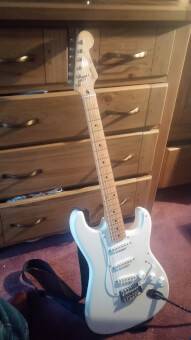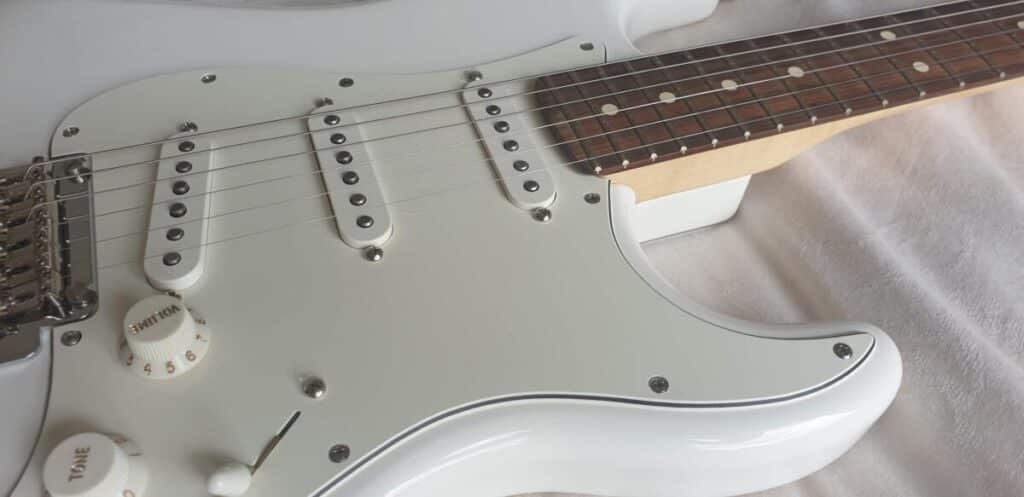Looking back through my Electric guitar history, I’ve owned eight Stratocasters over the years. Why does it feel like coming home again this time around?
Hondo Stratocaster copy.
1990(ish). Candle Apple red. Rosewood fingerboard.
My first guitar, used with a fly-sec headphone amp. Looking back, it was decent enough to make me want to continue with the guitar, even though I had no idea at the time of the other options available. The first lick I learned, the live solo of Who Wants to Live Forever by Queen was on this guitar, and later on, it helped me through books 1-4 of Russ Shipton’s guide to Rock & Pop guitar. I was hooked and perhaps bonded to the Fender Stratocaster forever.
Fender Japanese Stratocaster.
Late 1980s. Candy Apple red. Maple fingerboard. System 1 Bridge/trem with locking nut.
My first proper guitar, or so I thought. I proudly barged into McKay’s Music in Newcastle with one aim; to come away with a guitar that was going to take my playing to the Stratosphere! (no pun intended).
I turned my nose up at a black USA Fender Stratocaster, which had a hard-tail and was £50 out of my price range, in the days of cash-only and no credit arrangements, and chose what I thought was some sort of speed machine, with the notoriously bad (although I didn’t know it at the time) System 1 Trem.
But I beared with. You couldn’t use the trem without it going out of tune. You couldn’t bend a string without a high chance of it breaking. String changes were a nightmare with that locking nut. But (apart from the trem) it was beautiful, it had a neck to die for, and all the classic Strat tones were present and correct. For all its faults, this was my first real encounter with a real Fender Stratocaster, and I was willing to forgive it for almost anything until I discovered I could save myself the pain with a Les Paul, fixed bridge type instrument.
My lasting memories of this instrument are it’s the one I got really good at the guitar with. I learned music theory on this, and the ability to play along to songs using scales, ultimately writing my own music. Proof that even a flawed instrument shouldn’t stop you. Most of all, I vividly remember the day I ran this through a maxed-out Squier 15-watt combo and experienced my first guitar playing itself moment I’ve rarely recaptured.
These particular Stratocasters are fairly sort-after these days. No idea why.
Fender Mexican Stratocaster.
1990’s. Black. Rosewood fingerboard.
It was a while before I gave Strats another chance, but in the midst of trying to find my voice with 335s, p90’s, etc, I reasoned I still hadn’t owned a solid, reliable Strat that functioned as it should, but the safe option of this one didn’t provide any zing whatsoever. A wholly vanilla experience from start to finish, sonically and under the fingers.
This particular Stratocaster accompanied me on the first rehearsal of a band I just couldn’t get into. Couldn’t get into the music. Couldn’t get into the guitar. Was this the end for me and Strats? Not yet, but once again, I switched back to the instant gratification of a Gibson Les Paul Standard.
Fender USA American Standard Stratocaster.
1997. Darkish Pearl blue. Rosewood fingerboard. Block saddles.
As the single-paced mud of the Les Paul grated on me, I once again foolishly entered Making Music in North Shields with a hot-head, zero homework, and the sales savvy of a charity worker. This was the first inkling I had that I should stop messing about with anything else and return home, to my first love. I saw this gleaming example up on the wall, a USA Standard no less, and talked myself out of about £500 in the process, as I handed over my almost new 1998 Ebony Gibson Les Paul Standard.
And it sounded amazing, better even than the Japanese one. It inspired me, I produced some more music and even got into gigging with it for a bit. This would have been a guitar for life, if only for the state of the frets.
Looking back, a fret-level would have sorted it, but I didn’t have the nouse, the experience, or the funds at the time. Guitars to me were, and still are, an emotional thing. I was disappointed, I had fallen out of love with it, and I knew I needed to move on to probably another horrendously unfair trade-in.
Yup. Back to Les Pauls, A Gordon Smith Graduate 60, followed by a Gibson Les Paul Studio, where I stayed for 10 years.
Squire Stratocaster.
2000’s. Sunburst. Tortoiseshell scratchplate. Rosewood fingerboard.
This one was a curiosity really, I was still cheating with the Studio, but in the back of my mind, I was always thinking of the liquid playing experience, the natural fit, and the bonding I had with the Strat.
I had the £80 asking price burning a hole in my pocket, so why not?
This was the cleanest guitar I’ve ever heard. Too clean, to the point that any sort of overdrive/distortion wasn’t an option. Should I have bothered coming back? Was the Strat ever any good?
Squire Japan Stratocaster
1990s. Olympic White. Maple fingerboard.
Then one day I saw this in Fretmarks Guitar in Bedlington, and I fell in love all over again, paying over £350 for a 30-year-old FugiGen Squier. In hindsight, these are the very guitars that Yamaha mocked so brutally(and successfully) as being plywood in their solid-bodied, Pacifica campaign of the 90s.
But I didn’t care. Just look at it.

This guitar also introduced me to the delights of a 7.25″ radius fingerboard. It simply melted into my hand and brought it all back to me all over again. This is the one, isn’t it? I was almost done with anything with a 12″ radius (including Les Pauls). It feels like without the extra radius, my fingers are kind of stretching further across the board, which feels unnatural, uncomfortable, and weird.
But there were two big buts. Although I loved the 7.25″ most of the time. Big high bends and a low action were out, as they weren’t physically possible with this setup, and, I don’t know, despite the looks and the misty-eyed FujIGen nostalgia, this was a very cheap feeling and sounding budget instrument in all honesty.
But, crucially, although I’d now started to explore Telecasters for the first time, the Stratocaster flame had been lit once again.
Squier Affinity Stratocaster 20th Anniversary
2002. Dark Metallic Blue. Rosewood fingerboard.

After a round of gigging with the ever-reliable Squier Telecaster Custom, into lockdown we all went, and something unexpected. A really kind gift from my Son’s auntie, which obviously I needed to examine…
It arrived in a bit of a state, needing a replacement tuner, a clean-up of the electrics, and a good bit of TLC and elbow grease, but this battered, unassuming little Squier made me fall in love with the Stratocaster all over again.
The thing was, once I’d fixed it up, cleaned it up, and set it up (including a bit of DIY fret filing), this guitar represented the only Strat I’ve owned in 32 years with not a single issue. Ok, the electrics are noisy but that’s what 30 years of abuse does to you.
I found myself noodling about, unamplified, on the sofa, in bed, for hours on end, just like in the beginning, simply enjoying the fretboard, the contours, and the acoustic tones, working on my playing. I could never do that on the heavy and cumbersome Les Paul.
It was almost time to come home again.
Fender Player Stratocaster
2021. Polar White. Pau Ferro Fingerboard. (Fender 75th Anniversary).

So here I am. I knew the next guitar purchase I made would be one to last me a while, perhaps till the end, and everything was pointing me in the direction of home, back to the Fender Stratocaster once again, right back to where it started.
I wanted to buy new to minimise the chance of fret issues etc, but also to choose the colour. It had to be Polar white and my preference of the warmer sounding, more luxurious feeling rosewood (now Pau Ferro) board.
It was every bit as perfect as I’d hoped. But from the start, I wanted to do things right. Do the measurements and set it up to standard Fender spec of 0.01″ relief and 4/64th action. I wanted a professional instrument adjusted to the official specs to last me a lifetime.
Now? No other guitar is getting a moment’s thought. It’s always been about the Fender Stratocaster, and finally, with this new Player, I’ve got my hands on one that both sounds and plays amazing.
It’s a big upgrade from the Squier, not least the quieter and better quality electrics, but every little thing is better. The tone, the playability, the quality. It’s devoid of all the issues I’ve been lumbered with over the years. The trem works beautifully, strings don’t snap when you bend them.
There are a few strats in this list that have been weak, limp, overly bright sounding, or simply boring. This isn’t.
And finally, the 9.5″ inch radius fingerboard is the best compromise. No choking on bends but not too flat either.
But it’s not about measurements and specs. Most importantly, I’ve been on a journey since I was 16 to find my voice so to speak on the guitar. The Stratocaster has frustrated me at times but even though I’ve owned a few it’s only really been the last two that have confirmed what I guess I always knew.
The Fender Stratocaster will always be my home.
(Full review of the Fender Player Stratocaster coming soon).

Leave a Reply